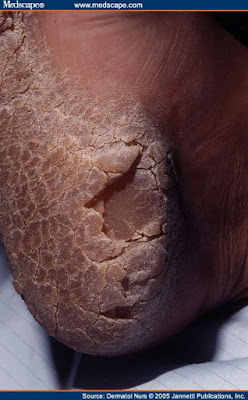This article is for Medical Students & Professionals but non-medical individuals may also find it useful.
In this article:
History of hyperkeratosis
Description of the hyperkeratotic lesion
Typical location of hyperkeratosis
Hallmark of hyperkeratotic disease
Treatment of hyperkeratosis and hyperkeratotic lesions
Normal course of hyperkeratosis
Patient education on hyperkeratosis
Nursing measures for hyperkeratosis
Presenting history of hyperkeratosis
This 31-year-old African-American female presented with a 20-year history of severe hyperkeratosis of the bilateral plantar areas. The keratoderma began in her preteen years and by the age of 17 had covered almost the entire soles. She has gradually developed deep fissures that have added more pain to an already uncomfortable condition. Because of the pain, she developed an abnormal gait.Description of the hyperkeratotic lesion
On examination, there are diffuse and well-defined areas of hyperkeratosis on the soles (see Figure 1). These thickened areas are more prominent on the heels (see Figure 2) than the balls of the feet and are not present on the insteps. The hyper-keratosis has a scale-like appearance and is slightly yellow in color. Large and small fissures are scattered throughout. There are no areas of erythema or drainage. Both feet are malodorous. |
| Fig 1: Diffuse and well-defined areas of hyperkeratosis on the soles. Image credit: Medscape |
 |
| Fig 2: Thickened areas are more prominent on the heels. Image credit: Medscape |
Typical location of hyperkeratosis
Keratoderma affects the palmar and/or the plantar surfaces of the skin. On occasion, the thickening may extend to the lateral or dorsal surfaces, and may also cause dystrophic nails.Hallmark of hyperkeratosis
The classic finding in this disease is the evidence of its existence in prior generations.Treatment of hyperkeratosis and hyperkeratotic lesions
Treatment can be very difficult and will be a lifelong effort. Some patients respond to systemic retinoids or topical creams of salicylic, lactic, or glycolic acids. Dermabrasion and CO2 laser ablation are the preferred treatments for mechanical debridement. This patient was treated with a combination of dermabrasion and CO2 laser ablation performed under regional intravenous anesthesia or Bier block. This procedure removed a bulk of the keratotic area, which will now need to be maintained with a vigorous approach.Normal course of hyperkeratosis
Keratoderma is an inherited genetic disorder. It can occur in the first few months of life and almost always presents by age 3. Clinically there is a bilateral yellow thickening of the skin. This thickening varies greatly from rough to smooth and scaly to waxy. Fissures may or may not be present. These areas are usually hyperhidrotic, which causes a constant foul odour. A very slight line of erythema can be noted along the outer border.Patient education on hyperkeratosis
Patients and their families should be educated about this inherited disorder. Specific skin care includes frequent soaking of the affected areas to soften the skin and using topical medications to keep the areas soft. A demonstration of paring, filing, or using a pumice stone to regularly debulk the areas may also be very helpful.Nursing measures for hyperkeratosis
A key action is to help the patient understand that this is a lifelong process and that means a dedicated routine of skin care. The increased risk of bacterial and fungal infections of the feet should be stressed as part of patient education.Source:
The above article is reproduced from material entitled 'Keratoderma' as provided by Medscape Dermatology. Note: Materials may be edited for content and length.

No comments:
Post a Comment
Got something to say? We appreciate your comments: